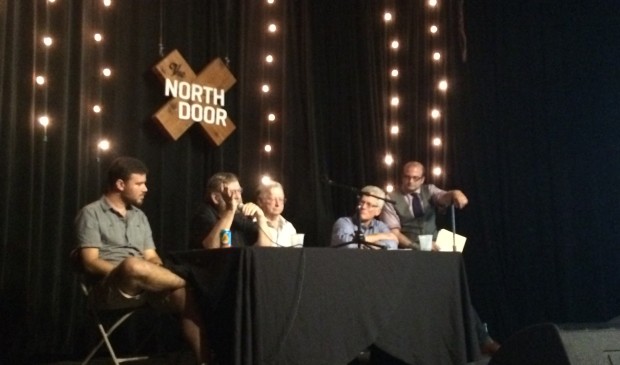Panelists discuss growth policies at BBB forum
Tuesday, July 28, 2015 by
Tyler Whitson The cranes crowding Austin’s skyline reveal that the city is growing quickly. But is it growing in a sustainable way? And what policies and strategies can city leaders adopt to ensure that it does?
These are some of the questions that a group of growth policy advocates discussed Monday during a forum at the North Door entitled “The Economics of Imagine Austin.”
Austin Monitor Publisher Mike Kanin moderated the discussion, which consisted of Land Development Code Advisory Group members Jim Duncan and Jeff Jack, AURA board member Steven Yarak and Planning and Zoning Department CodeNEXT Project Manager Jim Robertson.
Robertson described the concept of sustainability as a “three-legged stool” held up by environmental, economic and social principles. He tied all three concepts to the Imagine Austin 30-year comprehensive plan, which City Council adopted in 2012, and the CodeNEXT process.
“Imagine Austin’s vision of a compact and connected city very much aligns with environmental sustainability,” Robertson said.
CodeNEXT is a comprehensive rewrite, currently underway, of the city’s Land Development Code, with Council adoption of the new code planned for next summer. Its goal is to clean up the code that governs development in the city to make the process more streamlined and in line with Imagine Austin.
Jack framed the concept in terms of compassion. “When we look at a sustainable community … we’re talking about (it being) prosperous for everybody,” he said. “But if we can’t build a community that we can still afford to live in – if you’re a moderate- or lower-income person – we have failed, even though it’s a shining city that has a lot of bells and whistles.”
According to city demographer Ryan Robinson, the most recent poverty-rate data likely indicates that lower-income residents are moving out of the city into surrounding areas, such as Bastrop County, as property valuations in Austin continue to rise.
Duncan called Austin a city of “haves and have-nots,” referring to a February report that finds that Austin has the highest level of economic segregation of any large metropolitan area in the United States. “Sustainability is when real estate moguls, bleeding hearts and tree huggers can all sit around the campfire and sing “Kumbaya” together. Austin is a long way from that,” he said.
Yarak agreed that the city has far to go. “I would not say that the path we are on is one of sustainability,” he said. “We need to make room, and we need to make it a possibility for everyone to be able to come here.”
While all of the panelists agreed that the city faces major challenges, there was considerable disagreement on how to address them.
“We have to ask ourselves, what is going to make the decisions for us?” Jack said. “Is it going to be mythology, or is it going to be data? We can’t go off on planning exercises based on mythology.
“We’ve heard some of it already tonight – compact and connected,” Jack continued, referring to a comment from Robertson.
CodeNEXT is one of eight “priority programs” within Imagine Austin. The others are improving mobility through “compact and connected” development, maintaining household affordability, preserving the environment, conserving and improving water resources, developing a skilled workforce, creating a Healthy Austin program and growing a creative economy.
Yarak argued strongly in favor of relaxing zoning regulations in the central city as part of CodeNEXT. “If it doesn’t include a massive liberalization of the urban core land, then it’s going to be a failure,” he said. “We’re going to get continued economic segregation, we’re going to get continued high prices, we’re going to get continued property tax rises.”
Jack fired back at the assertion. “Liberalization of the zoning plan really means getting rid of most of the middle class in our central city neighborhoods,” he said.
Duncan expressed hope that CodeNEXT will help the city address some of its planning problems, noting that the last comprehensive code rewrite took place in 1986. “It will allow us then to stop zoning by variance, which is the worst thing a city can do, because it’s not predicated on anything,” he said.
Robertson connected land-use issues to the city’s congestion and transportation problems. “We have got to think about solutions that link our land use and our transportation investments,” he said.
The previous Council selected an approach to CodeNEXT last December, and the current Council affirmed it on June 18 with minor amendments. The selected approach allows the city to apply form-based code to an increasing number of neighborhoods and activity centers over time.
Form-based code is a land development code approach that is based on the physical form of development rather than the more traditional land-use strategies and is associated with walkable landscapes.
Those tasked with guiding the CodeNEXT process are consultant Opticos Design, the Land Development Code Advisory Group and representatives from several city departments.
The event was the most recent installment in the “Beers, Brains and Betterment” series presented by the Capital of Texas Media Foundation and the Austin Monitor.
You're a community leader
And we’re honored you look to us for serious, in-depth news. You know a strong community needs local and dedicated watchdog reporting. We’re here for you and that won’t change. Now will you take the powerful next step and support our nonprofit news organization?




